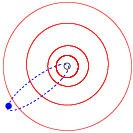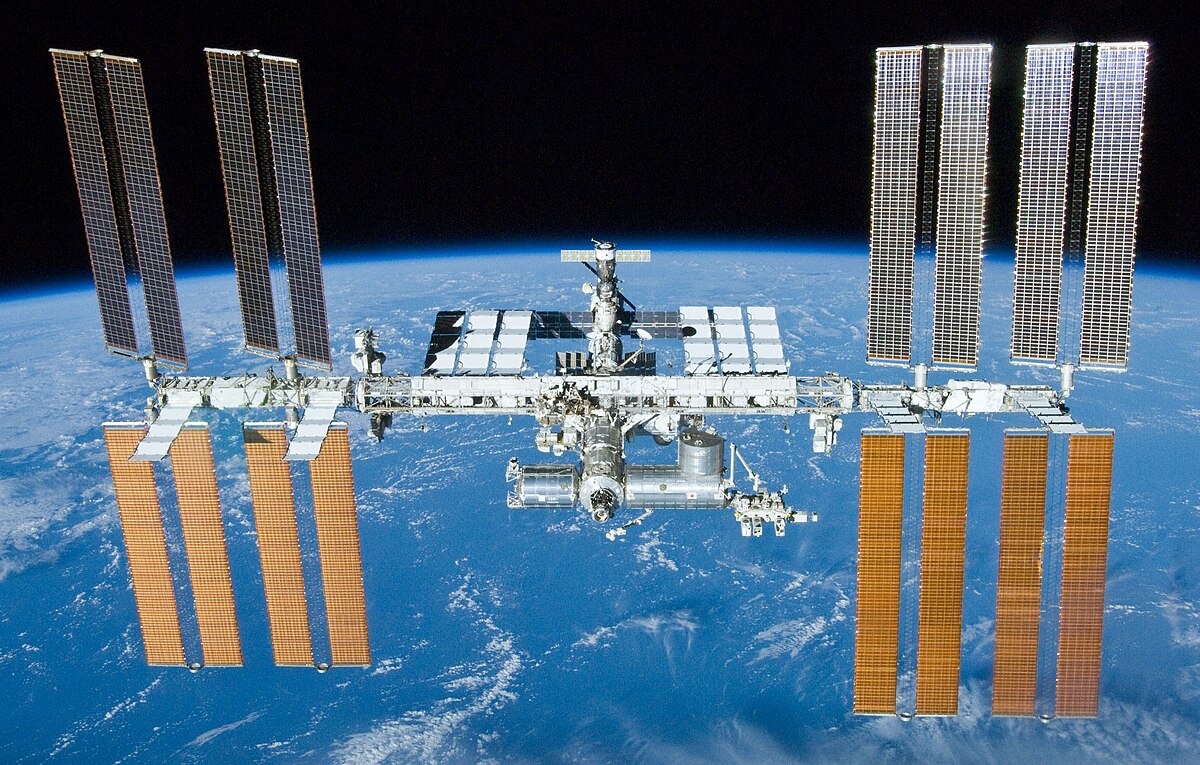These may seem like difficult questions but the answer is quite simple once you understand Newton's Cannon (images below are from this link).
When Issaac Newton was coming up with his ideas about gravity he first did a thought experiment (and it wasn't getting hit on the head with an apple).
- What can happen if you went to the top of a very tall mountain and shot a cannon, ignoring the effects of wind resistance?
 |
| The cannonball returns to the earth. It is moving too slow to achieve orbit. |
 |
| The cannonball travels fast enough to not return to the earth but not fast enough to escape Earth's gravity. |
 |
| The cannonball travels fast enough to escape Earth's gravity. |
This may seem like a simple concept but much more powerful than it appears. In fact this thought experiment leads me to one of my biggest pet peeves in science fiction movies.
- Look on the second image above. The cannonball is in orbit around the earth and will continue circling until acted on by another force. If you wanted to return to Earth should you travel faster or slower?
The answer is slower yet in many movies set in space we see them fire their forward engines to land. The truth is to go slower which would mean they'd need to turn their ship around before firing their rockets and let gravity can return them to the surface like the less powerful cannonball in the 1st image. Of course this seems counter-intuitive so the movies don't do it.
 One of Newton's ultimate discoveries was the formula to the left. It essentially states there is a constant force dependant on the two body's mass and distance between their centers.
One of Newton's ultimate discoveries was the formula to the left. It essentially states there is a constant force dependant on the two body's mass and distance between their centers.For things living on the surface of the Earth, the force gravity at sea level is written as 9.81 meters per seconds squared. In other words, if Newton dropped his cannonball off the mountain in the illustrations above, it would be falling at a rate of 9.81 meters per second after 1 second, 19.62 meters per second after 2 seconds, and so on. That's actually a bit of a misstatement because gravity at the top of a mountain is weaker than 9.81 but I hope you get my point.
The key takeaway is that gravity is a constant force but is also dependent on how far you are from an object. For objects in orbit around the earth like the middle illustration above it also means you have to move faster to stay in orbit the closer you are to the planet.

Halley's Comet is a good example of this in action. Halley's circles the sun once about every 75 years circling the sun near the orbit of Mercury and then hurtling back into the Solar System just past Neptune where it gradually slows, circling back for it's next transit around around the sun. The comet's speed in the outer Solar System is a little under 900 meters per second or 2,000 miles per hour. That may seem fast on Earth but it is a mere crawl in the vastness of space. In contrast the speed as it approaches sun is over 150,000 miles per hour. For comparison's sake, the fastest human travelers, the astronauts in Apollo 10, went about 25,000 miles per hour on a trip to the moon. This is why Hallys Comet only spends a couple of weeks in the inner solar system but takes so long to return visit.
The International Space Station is about 250 miles above the surface of the Earth and using Newton's formula to calculate gravity, it shows the Earth pulling on it at a rate of or about 90% of the effect on Earth.
Sidenote: Why do the astronauts appear weightless on the ISS? - Because they are in a constant free fall around the earth and the effect is similar to the feeling of weightlessness at the top of a roller coaster. They still are under the effect of gravity but the horizontal movement negates it.
 The International Space Stations travels from west to east around the Earth at about 17,200 miles per hour making a complete orbit every 92.65 minutes or 15 times a day. It cannot go any faster or it will no longer have a circular orbit. It can't go slower or the station would crash into the Earth.
The International Space Stations travels from west to east around the Earth at about 17,200 miles per hour making a complete orbit every 92.65 minutes or 15 times a day. It cannot go any faster or it will no longer have a circular orbit. It can't go slower or the station would crash into the Earth.As you move out from the planet, the Earth's gravity will be even less meaning your speed to stay in orbit will also be less. For example the moon travels at just under 2,300 miles per hour and makes a complete circuit of the Earth once every 27.3 days.
With this information we are now are able to answer the questions I raised at the beginning.
- Why doesn't your satellite dish need fancy tracking software to get a constant signal?
The trick is to put the satellite in orbit that matches the rotation of the Earth, also known as a geosynchronous orbit. If you raise a satellite to the distance of 22,236 miles, it's speed will exactly match the speed of the Earth's rotation.
- Why do you need to always point your dish to the south?
Gravity ensures that all orbits must circle the center of mass. A look at the image to the right shows the inclination of typical orbits. The Yellow Orbit is the International Space Station which is inclined at 52 degrees The Red Orbit is a typical orbit inclination used in rockets launched by the United States and inclined at 28 degrees.
As you can see from this image, an orbit with any inclination will move a satellite north and south through the day which is useless for companies that want their equipment to be able to easily find satellites in the sky. An equitorial orbit for anyone in North America is always found in the southern sky.
Did that really answer the question?
Not exactly as you need to combine both concepts I described above. Most communication satellites use a Geosynchonous Equatorial Orbit also called a Geostationary orbit.
Satellites in Geostationary Orbit appear to hang in the same point of the sky, ignoring the pull of gravity. Here's a time lapse picture from Adam Block of the night's sky last week. All the stars move. The geostatic satellites do not. (It's much clearer on his website but warning: It's a big file.)
This concept has been a boon for companies like DirecTV who use it to avoid the cost of running wires all over North America and combine it with cheap satellite dishes. The only downside is the massive cost of sending a satellite 10% of the way to the moon. That distance also is one of the reasons why your local stations are a little ahead because even at the speed of light, it takes the signal a quarter second get to the satellite and back to Earth.
As you can see from this image, an orbit with any inclination will move a satellite north and south through the day which is useless for companies that want their equipment to be able to easily find satellites in the sky. An equitorial orbit for anyone in North America is always found in the southern sky.
Did that really answer the question?
Not exactly as you need to combine both concepts I described above. Most communication satellites use a Geosynchonous Equatorial Orbit also called a Geostationary orbit.
Satellites in Geostationary Orbit appear to hang in the same point of the sky, ignoring the pull of gravity. Here's a time lapse picture from Adam Block of the night's sky last week. All the stars move. The geostatic satellites do not. (It's much clearer on his website but warning: It's a big file.)
This concept has been a boon for companies like DirecTV who use it to avoid the cost of running wires all over North America and combine it with cheap satellite dishes. The only downside is the massive cost of sending a satellite 10% of the way to the moon. That distance also is one of the reasons why your local stations are a little ahead because even at the speed of light, it takes the signal a quarter second get to the satellite and back to Earth.



No comments:
Post a Comment